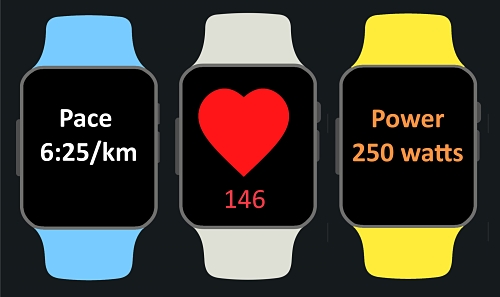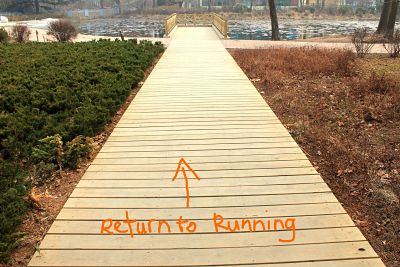Running Power vs Pace vs Heart Rate
 Running Power vs Pace vs Heart Rate
Running Power vs Pace vs Heart RateRunning power vs Pace vs Heart Rate and which one should you choose for training and racing? All are very different but what most runners want to know is which method is going to make you a faster and better runner.
Running by Pace
Most people when they start running or especially if they are training for their first race, tend to train by pace. The debate of running power vs pace vs heart rate is not really thought about.
Why? Because traditionally pace has been the golden number and because all running watches record at least pace, time and distance.
Everyone loves to compare paces and to see if they were faster than the last time they ran or faster than their running buddy or their competition. Pace can show improvement and can be a great moral booster.
However, you need to bear in mind that although training by pace can be a great tool, you need to use it correctly. Unless you have a lot of running experience or a coach to guide you or have some races under your belt to show your capabilities, you are primarily guessing at what pace to run. How do you know what is "easy" pace or "tempo" pace? This can lead to over training or injuries.
Using pace can be great on the flat or at short distances but the longer the distance or the more technical the terrain, the more difficult it will be to maintain your pace. Try running the same fast pace on the hills as on the flat and you are going to gradually slow down.
Added to that, pace doesn't take into account that you might be having a bad day and feeling tired or sick. Pace is just a number that shows how fast you are going and doesn't take into account anything else.
It is a proven fact that most runners using pace, way understimate what they think an easy pace is. Not only that, easy runs should be the main bulk (80%) of your training, yet many runners do less than 50% as easy runs. Easy pace varies from runner to runner but in all cases, you should be able to hold a conversation comfortably.
If you have been running by pace and are feeling tired all the time or that you are not improving, or worse still, are getting injured, then maybe it is time to look at the alternatives.
----- running power vs pace vs heart rate -----
Heart Rate Training
With the running power vs pace vs heart rate debate hotting up, heart rate (HR) training is certainly becoming more and more popular, especially now that a lot of GPS running watches have built in HR wrist monitors. You can also use a chest band HR monitor or an armband HR monitor which is what I currently use.
With HR training, you forget your pace and you train by your heart rate. Your heart rate reacts to body stresses such as injury, sickness or tiredness so your HR will tell you if you need to run slower that day or whether you can pick up the pace a bit.
Phil Maffetone is one of the best known mentors of HR training and his method is referred to as MAF training.
HR training aims to make sure that you are running at the right pace for you at that moment. If you've had a poor nights sleep, your HR may be higher than usual so you will need to run slower to stay at the planned HR. Your body is self adjusting. Over time as you improve and get stronger, you will find that you can run faster but at the same HR so you will be feeling less exhausted but able to run faster.
HR training can be a perfect method for those who are new to running, who are not feeling their best, are returning from injury or who just want to run for pleasure and fitness. Many ultra runners swear by HR training too as it allows them to run longer and further with less exhaustion.
There are a few caveats though, mainly in that HR tends to lag. You might for example be trying to reach a certain HR but find it takes a while to get there although you are running hard. Or you might get cardiac drift whereby your HR continues to rise although your pace is slowing down. HR is also very sensitive so it might be confusing to know if it is stress or caffeine or excitement that is causing your HR to rise.
Some people are reluctant to try HR training as they think that is all about slow running. However that is not the case, as it is perfectly fine to use the 80/20 approach whereby you do 80% easy running with 20% faster runs.
If you want to find out more, consider Phil Maffetone's, The Big Book of Endurance Training and Racing.
If you are interested in HR training for particular race distances, then look at Matt Fitzgerald's 80/20 training plans.
(Please note that as an Amazon associate I earn from any qualifying purchases)
----- running power vs pace vs heart rate -----
Running Power
If you are a cyclist you may have already used a bike power meter. For runners though, it is a very new tool.
Running power is measured in watts and is a measure of your running intensity and effort. The more power that you can produce, the more speed that you can produce too.
Running Power vs Pace vs Heart Rate
- Power is a measure of the work/effort that you are doing and at what speed.
- Pace is a measure of what speed you are doing but not the work/effort involved.
- Heart rate is a measure of your body's reaction to the work/effort that you are doing.
The more I read about running power, the more interesting and logical I think it gets for runners, especially those who want to preform to the best of their abilities.
One problem though is that being a very new running tool, there are not many running power meters on the market and also there is not a lot of documentation compared to other running metrics.
One of the most comprehensive and developed running power meters is the Stryd Footpod. The Stryd is attached to your shoe and paired to your watch. It then uses accelerometers to monitor your body movement (forwards, sideways and upwards). From this information it can calculate your power output in watts. The higher the watts, the harder that you are working. Here's my personal review of the Stryd Footpod.
It also takes into account your weight, so that a lighter person will need to produce less watts than a heavier person in order to produce the same speed. From all this information, Stryd can predict training zones (in watts) and can predict a suitable race power (in watts).
The advantage of running with power is that your effort and intensity is quantified into one single power watt number and it is an instant measure. There is no need to check pace and heart rate and you can see instantly if you are hitting your target as there is no lag like you get with HR. If you encounter a hill, you just make adjustments so that you are on your target power. This might mean smaller steps or slower pace but the effort will remain the same.
A power meter is also a great training tool. Your power is a measure of your movements horizontally, laterally and vertically. This means that you can experiment to see where you might be wasting power. For instance, you might find that by adjusting your body posture, stride length or cadence, that you can change your power output.
Where power can be invaluable, is racing, especially on non technical terrain or in road races. Through training, you will be able to calculate the power that you can hold for a particular race and then you just run, sticking to that power. Excitement, stress and hills make no difference to your power output. You just stick to your planned power number and the speed will follow.
As a comparison in a race situation using the 3 methods:
- With HR, as your race starts, you might find that your HR is already high due to excitement and stress or that last coffee, so trying to stay in your planned HR zone is going to be tricky.
- With pace, you have to be careful not to run out of energy if your race is hilly or there is lots of surging. If you try and maintain the same pace throughout, you will certainly be using more energy and effort on the hills or where the terrain is uneven.
- With power, you will be running at the same power throughout the race, whether it is hilly or flat, windy or calm. This ensures that your effort remains the same throughout and you are much more likely to have a strong finish or even a negative split.
----- running power vs pace vs heart rate -----
Running Power vs Pace vs Heart Rate Conclusion
So when deciding between running power vs pace vs heart rate training, all three training methods in fact have their place and the method(s) that you use depends on what sort of runner you are and what you are trying to achieve.
All of them, if used correctly are great training tools and they can all be used with zone training. For many, HR training and pace based training are used together. Power training is gaining ground although right now not many runners or coaches are familiar with it. However running by power could well be the next big tool in running, used on its own or alongside pace and heart rate training.



